On an October morning 25 years ago, MarketWatch started providing real-time news and market data to the general public on the internet. Individuals were fleeing their stockbrokers for new online platforms, like E-Trade and Charles Schwab, and hungry for financial data and information that did not cost upwards of $10,000 annually to access.
The MarketWatch newsroom was built with these readers’ needs in mind and for the next 25 years we provided them unbiased coverage to help them make sense of financial markets and their personal financial decisions.
As MarketWatch marks its 25th anniversary this week, we are looking back at the 25 biggest market events and developments that we have covered. These MarketWatch Moments shaped our current capital markets and will continue to reverberate.
1. Online brokers and the rise of the day trader

Getty Images/iStockphoto
The internet and the discount brokerage model combined in the late 1990s to unleash a powerful new force on financial markets that was led by E-trade and Charles Schwab
SCHW,
By 1998, million of Americans had moved their retail trading activities online, reshaping Wall Street forever. The internet also offered individual investors access to financial information, ranging from securities filings to market-moving news and data provided by emerging news organizations, like MarketWatch. CNBC’s market news became the default channel in waiting rooms and airport lounges and stock-market message boards were overrun with trading tips.
Online brokers promised low commissions and a vehicle for quick trading profits. E-Trade ads in the late 90s tapped into a fear of missing out on a boom. One ad during the Super Bowl featured a patient being wheeled into an emergency room, suffering from a condition diagnosed as “money out the wazoo.” An estimated 10 million people quit their jobs to become “day traders,” adding to the frenzy around internet and technology stocks.
Sometimes it felt like the Wild West and the abuses were real. But it was also clear that lower costs and easier access to information empowered individual investors to become active market participants, and would pressure Wall street to serve them better.
2. Russian ruble devaluation and LTCM
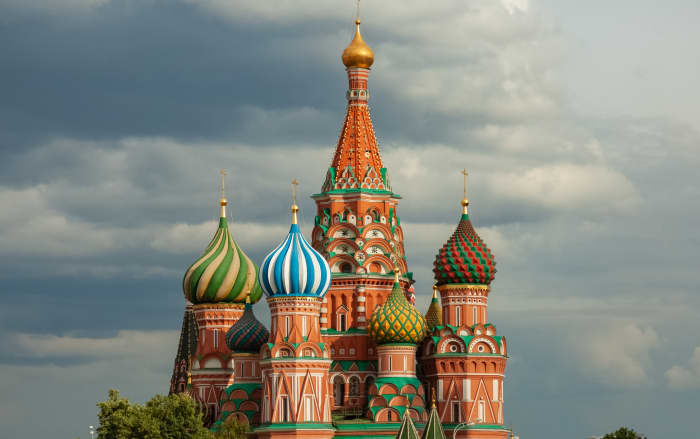
Getty Images/iStockphoto
Brains aren’t everything. Despite employing two future Nobel laureates, Long-Term Capital Management went belly up in late 1998, becoming a watchword for investor hubris and systemic risk. LTCM was a world beater, raising over $1 billion between 1994 and 1998 as its leaders touted their approach that they bragged employed leverage to take advantage of bond and interest-rate arbitrage opportunities while cutting risk.
But it all went awry in August 1998 as Russian markets imploded after Moscow devalued the ruble, defaulted on domestic debt and declared a moratorium on payments to foreign creditors. LTCM’s highly leveraged exposure to Russia resulted in the hedge fund’s collapse, with the Federal Reserve coordinating a then-historic $3.6 billion bailout led by the fund’s creditor banks.
Those woes are regularly invoked during periods of financial stress, as wary investors keep their eyes peeled for the next LTCM. Investor Michael Novogratz in June labeled turmoil in crypto markets the industry’s “Long-Term Capital Management moment.” The original incident was the first time MarketWatch covered excess Wall Street risk-taking that resulted in a government-led rescue. But MarketWatch’s coverage of “bailout culture” would continue.
3. The 1990s tech bubble, IPO boom & bust

Getty Images
MarketWatch didn’t just cover the dot-com boom and bust, it participated in the frenzy. The fledgling news site was one of many San Francisco-based companies that rushed to complete business plans with an eye toward immediate Wall Street riches. The initial public offerings of the era often didn’t depend on corporate financial performance, but instead were predicated on their ability to sell a new future.
Near the peak of the surge, MarketWatch went public in January 1999 at $17 a share, despite losing more than $8 million the previous year on less than $5 million in revenue. A valuation of roughly $200 million at the IPO price more than quintupled in just the first day of trading, making MarketWatch a billion-dollar company. Vincent Slavin, an institutional trader, was blunt when describing the MarketWatch IPO: “It’s complete lunacy.”
Other Wall Street analysts told Wired that MarketWatch was a “scrappy company” that unlike a newspaper “won’t have to contend with newsprint, delivery trucks, unions, and other messy expenses.”
All of this was part of what Federal Reserve Chairman Alan Greenspan described as “irrational exuberance.” Of course, the lunacy did not last. The bubble started to burst in April 2000 after a federal judge ruled that Bill Gates’ Microsoft
MSFT,
had violated antitrust law. The outsize valuations of the dot-com boom disappeared nearly in unison in the following months.
MarketWatch covered the implosion of companies like Pets.com and Webvan, even as its own stock price cratered, with MarketWatch shares dipping close to $1 in Sept. 2001. While many companies that had recently gone public went out of business, MarketWatch continued to find readers hungry for news about the markets, including dot-com bankruptcies and zombie stocks they left behind. In 2005, MarketWatch sold to Dow Jones for $18 a share, topping the original IPO price, and has survived long enough to cover the spiritual successors to those dot-com companies, such as Chewy
CHWY,
and DoorDash
DASH,
and to tell you why the second tech boom was nothing like the first.
4. Decimalization

AFP via Getty Images
Moving in response to a Nasdaq trading scandal, the Securities and Exchange Commission in 2001 forced U.S. exchanges to stop quoting stocks in ⅛ point fractions and move to decimals. In other words, quotes went from 12.5 cent increments to penny increments — a move that was seen as a boon to retail traders because it narrowed the spread between the bid and ask prices, but that also helped speed the development of electronic trading over the human touch.
Subsequent rule changes, culminating in what the SEC deemed the “National Market System,” had a similar effect, speeding technological trends that had been decades in the making while aiming to create a freewheeling market where exchanges and other venues, including electronic communications networks and so-called dark pools, would compete to provide best execution on trades.
A rise in high-frequency trading, or HFT — transactions conducted by powerful computers with high-speed connections to the various exchanges able to execute a large number of transactions in milliseconds or faster — was tied to market fragmentation. HFT firms were well equipped, for example, to take advantage of situations where a stock was trading at different prices on different venues. Critics charged that HFT distorted prices and encouraged market makers to vanish during periods of market stress.
The increased competition also contributed to the growth of a practice known as payment for order flow, in which brokers get paid by trading venues in return for routing their trades to them. Proponents argue that order-flow payments promote liquidity on Wall Street and facilitate zero-commission trading — to the advantage of retail traders. Detractors say it is a blatant conflict of interest and undermines the concept of fair markets. The backlash over the controversial practices has spurred fresh regulatory scrutiny, as well as an entrepreneurial response. IEX Group Inc., featured in Michael Lewis’s 2014 book “Flash Boys,” developed a trading platform with a speed bump aimed at discouraging high-frequency traders while shunning the practice of paying for order flow.
5. The 9/11 attacks
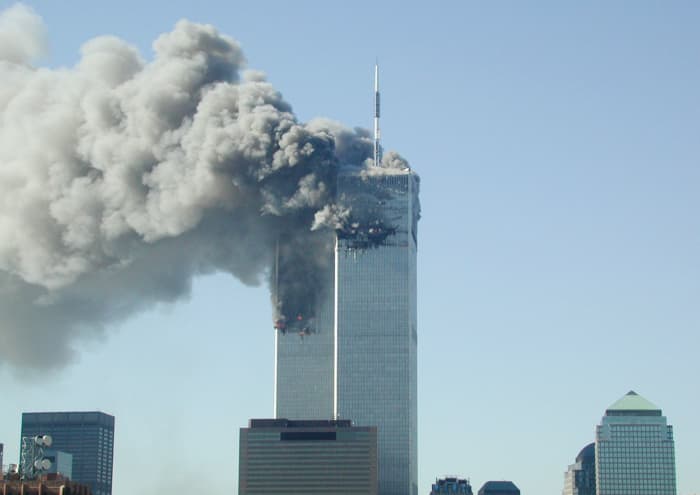
Getty Images
“Our primary concern here is for human life, but do we know whether any markets operating in that area have decided to suspend trading for today?” CNBC host Mark Haines asked shortly after the second plane hit the World Trade Center.
The human tragedy of 9/11 was overwhelming and the terrorist attack on the World Trade Center and Pentagon also clearly targeted financial markets and the people who worked to keep them functioning. U.S. markets did halt trading on 9/11 and the New York Stock Exchange would stay closed for four trading days, the longest period it had sat empty since 1933, during the height of the Great Depression.
But in the hours before those decisions were made and before Americans began to understand the true impact of 9/11, traders and other workers who would normally be commuting to or arriving on Wall Street, and their families, searched for information. News outlets, including ours, worked to provide them with whatever insight they could.
Dressed in a reddish brown pantsuit and pearls, Maria Bartiromo stood on the floor of the New York Stock Exchange as traders milled about and described what she had seen just moments before. “The first explosion that I witnessed was the second plane going into the second tower,” she told the CNBC hosts. “I was outside, frankly I ran for my life.”
As the day progressed, many websites buckled under the pressure of increased internet activity. But MarketWatch managed to stay online, and pulled ads from the site. A reader named C. Harrison, who said he didn’t have access to TV or radio at work, wrote to us in the aftermath, saying that the site “provided me and my coworkers with the only news of what was going on in the world.” Harrison added: “You will never know how much I appreciated being able to maintain the link throughout the day and get updated information, almost as it was happening.”
6. The Enron scandal

AFP via Getty Images
On December 2, 2001, Enron filed for bankruptcy court protection. At the time, it was the biggest corporate failure in American history and symbolized the excesses that had taken place in financial markets. A Houston energy and trading company, Enron had started 2001 as the nation’s seventh largest company with $100 billion in reported revenue and a high-flying stock before collapsing amid accusations of accounting fraud.
Employees were quick to point the finger at Enron CEO Ken Lay and other top executives. “He had to be aware of what was going on,” one employee told MarketWatch days after the bankruptcy. “Something about this is not legal. Something, somewhere is wrong.”
Federal prosecutors agreed. They criminally charged Lay and other top executives, like Jeffrey Skilling and Andrew Fastow, accusing them of employing accounting gimmicks to cook the books and mislead investors. All three were convicted, but Lay died before his sentencing. He always maintained his innocence.
The government also charged Arthur Andersen, one of the big five accounting firms and Enron’s auditor, of obstructing justice by destroying Enron documents. “Andersen shredded ‘tons’ of paper,” as MarketWatch put it in 2002. That same year, a federal jury convicted Arthur Andersen, causing the dissolution of the firm and the loss of 30,000 jobs.
In response to the Enron scandal, federal lawmakers passed the Sarbanes-Oxley Act, requiring sweeping new accounting and recordkeeping practices for corporations. Three years later, MarketWatch ran the following headline: “Andersen’s Conviction Overturned.” As MarketWatch told it, in a unanimous decision written by Chief Justice William Rehnquist, the the Supreme Court said “the jury instructions were flawed in important respects.” But the legal reversal could not undo the end of Arthur Andersen’s accounting business.
7. The subprime real estate boom & bust
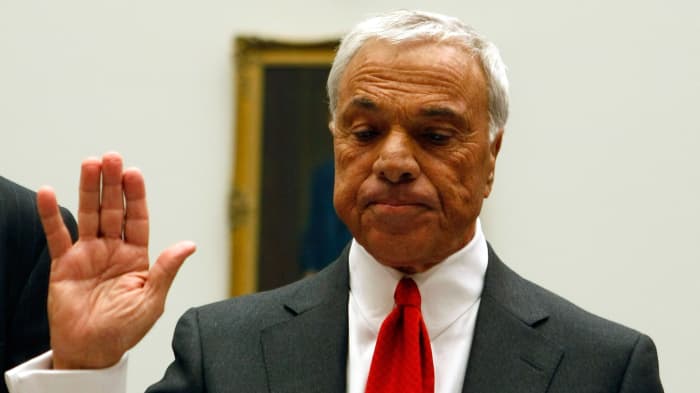
Angelo Mozilo, CEO of Countrywide Financial Corporation, raises his right hand as he is sworn in during a House hearing on March 7, 2008.
Getty Images
The Bronx-born son of a butcher, Angelo Mozilo became the perpetually-tanned face of the subprime mortgage boom. For years, his Countrywide Financial was the leading seller of home loans to people with poor credit scores who did not qualify for a conventional mortgage. Before 2000, this kind of lending barely existed. But many banks and specialty finance companies followed Mozilo’s lead, originating toxic mortgages that were then sold to Wall Street and government-sponsored entities, fueling an unsustainable increase in U.S. housing prices.
The subprime mortgage boom not only opened up the mortgage market to people who previously could not access home loans, it featured products that let them buy homes they truly could not afford. Across America people bought homes without making initial down payments, using loans that started out with artificially low teaser rates or required no early principal payments at all. Those financing terms would later reset and increase dramatically.
The erosion of lending standards was premised on the perception that housing prices only went in one direction: up. Wall Street and the federal government were happy to fuel this idea. For years, banks and government-sponsored enterprises had bought mortgages from lenders, funding their ability to originate more mortgages. The banks and GSE’s packaged the loans into securities that were sold to investors. With the subprime mortgage boom, the underlying mortgages became much riskier and Wall Street stepped up its financial engineering with ever more riskier products. But the big credit rating agencies, which were paid Wall Street fees, kept giving their highest ratings to the more risky products.
By March 2007, many American homeowners were unable to make their mortgage payments. Housing prices fell. Ben Bernanke argued that the problems associated with subprime loans were “contained.” MarketWatch reported that the Federal Reserve chairman at the time saw limited impact from subprime. “We do not expect significant spillovers from the subprime market to the rest of the economy or to the financial systems,” MarketWatch reported Bernanke saying.
8. The iPhone
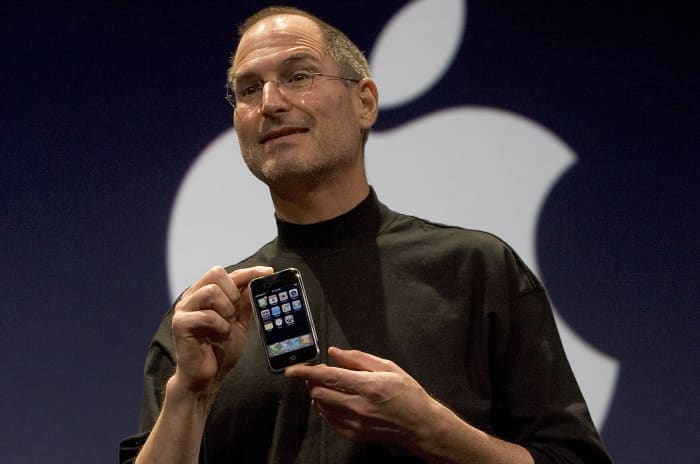
Steve Jobs holds up the new iPhone that was introduced at Macworld on January 9, 2007 in San Francisco, California.
Getty Images
On the day Steve Jobs introduced the world to the iPhone in early January 2007, most of the tech press was in … Las Vegas, covering CES, the massive consumer electronics trade show. The last-minute unveil at San Francisco’s Moscone Center sent several reporters at CES into a panic, and they booked the next-available flight to the Bay Area. They were not disappointed.
Longtime Silicon Valley analyst Tim Bajarin, who was in the audience that Tuesday morning, was instantly convinced Apple would create a new category in mobile computing. “We had mini computers, desktop computers and now with the iPhone, pocket computers,” he recalled. “I felt it could be Apple’s biggest hit ever.”
In a sit-down interview with Jobs following the debut of iPhone (it would eventually ship in June), the iconic Apple Inc. co-founder initially downplayed the social and financial significance of iPhone. Then, he warmed up.
“This is a revolutionary product that has the chance to really impact people’s lives,” Jobs told Jon Swartz, now a MarketWatch Silicon Valley correspondent. Jobs compared the iPhone to the original Macintosh and iPod. “This is the ultimate digital device.”
Jobs made a convincing case, demonstrating how iPhone users could make calls while viewing content on the Web and exchanging e-mail — all at the same time.
In the 15 years since its inception, the iPhone redefined the burgeoning smartphone market, kick-started Apple
AAPL,
into years of hyper-growth and made Apple the world’s biggest company by market capitalization, a title it recently lost to Saudi Aramco. Roughly half of Apple’s $365.8 billion in 2021 revenue came from iPhone sales. At the same time, developers are selling some $600 billion annually of goods and services through the App Store.
In total, Apple has sold more than 1.3 billion iPhones.
9. Lehman Brothers Collapses
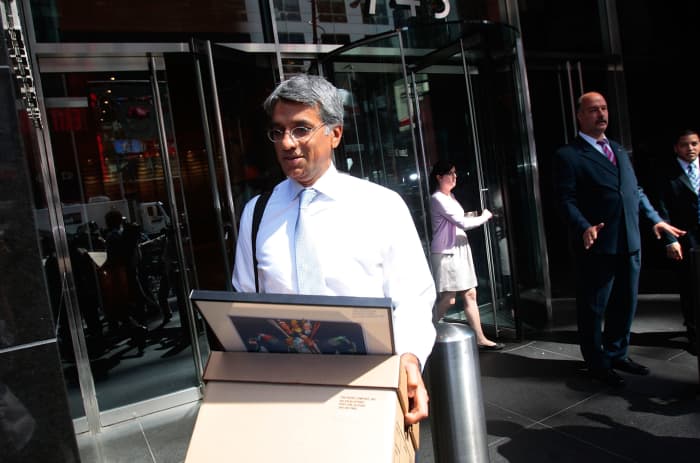
An employee of Lehman Brothers carries a box out of the company’s headquarters on September 15, 2008 in New York City.
Getty Images
On September 15, 2008, Lehman Brothers filed for bankruptcy. MarketWatch bore witness to the scene outside the 158-year-old investment bank’s Manhattan headquarters, describing it as “a media circus, with cameras lined along the Seventh Avenue sidewalk and reporters approaching employees for comments.” MarketWatch was among the media mob approaching the stream of employees leaving the building with boxes in their hands.
“Several dozen people went into the Lehman offices wheeling suitcases. One of them, who said he was with the research department at Lehman, was notified over the weekend that he had been laid off. He said he didn’t know how many people in his group had been dismissed, but that he was coming back Monday morning to ‘salvage what I can’ from his office,” MarketWach reported.
Lehman Brothers collapsed under the weight of souring real estate assets, sending shockwaves across the world and sparking a financial crisis. Within hours of the bankruptcy filing, one of the biggest money market funds was forced to “break the buck,” unable to fully pay its investors because of the Lehman Brothers commercial paper it held. MarketWatch reported how the Reserve Primary Fund “put a seven-day freeze on investor redemptions after the net asset value of its shares fell below $1.”
As global credit markets seized up, the Federal Reserve was forced to guarantee money market fund assets and participate in the federal government’s $182 billion bailout of teetering AIG, the insurance behemoth. MarketWatch quoted Andy Barile, an independent insurance industry consultant based in Rancho Santa Fe, Calif. “There must be something that can be done to stop this. There are too many financial consequences.”
The federal government’s dramatic intervention in markets, which featured Congress’ $700 billion bailout law, prevented the collapse of the financial system. But the financial crisis still triggered the Great Recession, and political backlash, like the Tea Party and Occupy Wall Street movements.
10. Satoshi Nakamoto
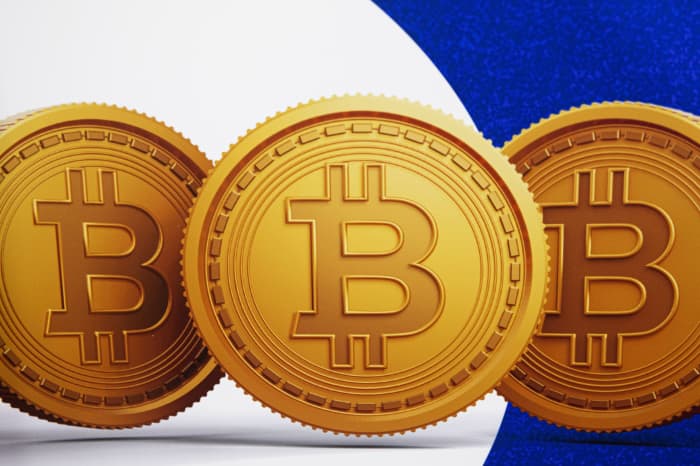
Lauren DeCicca/Getty Images
In October 2008, during the darkest days of the financial crisis, a person using the pseudonym Satoshi Nakamoto sent an email to a cryptography mailing list. “I’ve been working on a new electronic cash system that’s fully peer-to-peer, with no trusted third party.” Nakamoto published a white paper online detailing a digital currency. He called it bitcoin.
The true identity of Satoshi Nakamoto remains a mystery, but the technology he introduced has had a profound impact on markets. Bitcoin
BTCUSD,
popularized the idea of digital currencies powered by distributed software known as blockchain. There are now more than 12,000 digital currencies with a combined market capitalization of nearly $2 trillion. Bitcoin is still the most widely traded and highly valued.
It took a while for MarketWatch to catch onto the significance of bitcoin. Chuck Jaffe, a columnist, first described bitcoin for MarketWatch readers in 2011 as “a new form of currency that is not tied to any country or government, and that doesn’t actually exist in the physical world.” Jaffe noted that “the bitcoin system is run by the people who use it,” and added there are “no government officials to step in and mess things up.” He also compared it to tulips and Beanie Babies and suggested investors “still favor stocks and bonds and other investments.” At the time, bitcoin changed hands for $10.
Since then, bitcoin has been bid up above $40,000 and been mentioned in 5,300 MarkeWatch articles. The tickers of cryptocurrencies are among the most popular on the MarketWatch site. We even have a reporter dedicated to covering bitcoin and other digital currencies.
11. Europe’s debt crisis and the near-death of the euro

Taxi drivers marching in Athens during the height of the European debt crisis.
AFP via Getty Images
European officials were quick to lay the blame for the global financial crisis at the feet of out-of-control banking systems in the U.S. and U.K. But it wasn’t long before homegrown problems thrust the Continent into a crisis of its own that caused untold economic suffering, political, and social unrest; and nearly destroyed the euro.
The problems began in 2009 as a new Greek government revealed that the country had been running much larger budget deficits than previously disclosed. The pain spread, with countries such as Ireland and Spain seeing their previously sound fiscal records undone by the collapse of massive property bubbles. Shackled to a shared currency, devastated economies were forced to embark on internal devaluations in an effort to regain competitiveness.
A “doom loop” became the central feature of the euro-zone debt crisis, which came to a head in 2012 as borrowing costs for Spain, the eurozone’s fourth-largest economy, and Italy, the region’s third-largest, soared. The climbing yields on sovereign debt issued by stressed eurozone countries also reflected fears of “redenomination,” in which a country could leave the euro and see its creditors repaid in reconstituted pesos, drachmas or lira. That led to a bold move by European Central Bank President Mario Draghi, who delivered an unscripted pledge in a London speech in July 2012: “Within our mandate, the ECB is ready to do whatever it takes to preserve the euro,” he said.
The ECB proceeded to fashion an emergency bond-buying program that went well beyond anything it had used previously. The program, known as outright monetary transactions, or OMT, was never used, but its existence, and the accompanying formation of a eurozone bailout mechanism, served to calm the storm. But it wasn’t the end of the story. A showdown over another Greek bailout in 2015 again raised the specter of a country exiting the euro, and the ECB is currently scrambling to come up with a new “antifragmentation” mechanism that will serve as a backstop to keep yields for more indebted countries from soaring as it begins lifting interest rates in response to inflation.
12. The new tools of monetary policy

Former Federal Reserve Board Chairman Ben Bernanke
Getty Images
When the U.S. plunged into the 2007-2009 Great Recession, the dawn of a daring new age emerged at the Federal Reserve. One whose credo remains controversial to this day.
Out was the Fed’s conservative approach to managing the economy. In was a novel and aggressive effort to stimulate growth and a new-found openness at the U.S. central bank that was often invisible to the public.
The first big shift came in 2008. Worried that short-term interest rates near zero weren’t doing enough to revive the economy, the Fed adopted a strategy that became known as QE, or quantitative easing. The Fed began to buy government bonds and private securities composed of large numbers of home mortgages bundled together. These purchases eventually ran into the trillions of dollars. The goal: To flood the economy with money, drive down long-term interest rates, spur lending and encourage investors to buy riskier assets such as stocks.
The Fed has used QE repeatedly in the years that followed, most recently during the coronavirus pandemic. Its balance sheet has ballooned from under $1 trillion before the Great Recession to $9 trillion.
The second big change: The use of so-called forward guidance to keep interest rates from rising as the economy improved. For the first time ever, the Fed would explicitly tell investors what it planned to do and when.
The final tool in the Fed’s new toolkit was an effort to engage with the public, a huge change from a historically secretive central bank. Chairman Ben Bernanke in 2011 began to hold regular press conferences to explain the bank’s actions.
Has it worked?
Supporters contend the Fed’s makeover boosted the economy and saved it from tougher times. Critics argue the bank’s decisions more than a decade ago laid the seeds for the current bout of inflation — the highest in 40 years.
13. The Flash Crash

Flash Boy: British trader Navinder Singh Sarao
AFP via Getty Images
It was a 21st century crash. Around 2:32 p.m. in New York on May 6, 2010, the stock market suffered a short but jarring plunge. The Dow Jones Industrial Average suddenly extended a fall by 600 points before recouping most of the drop in minutes. At the worst of the afternoon freefall, major stock indexes were all down 8%.
Eerily, there was nothing to hang the plunge on: no sudden geopolitical disaster, no hawkish pronouncements from the Federal Reserve, no news that could be seen as a catalyst. While the indexes tumbled, the carnage in individual stocks was even more alarming. Shares of Accenture, for example, dropped from around $38 to a mere penny in a two-minute stretch, though such trades were later voided. The incident rattled brokers, exchanges and regulators.
A few months later, a joint report by the Securities and Exchange Commission and the Commodity Futures Trading Commission blamed a large fundamental trader, who they didn’t identify. The regulators said the trader executed a large sell order — valued at roughly $4.1 billion — using an automated execution algorithm at a time in the afternoon while the markets were already very stressed. The report concluded that combined selling pressure from the huge order drove high-frequency traders to drive down the price of the E-Mini S&P 500 futures market at the same time as it drove the liquidity providers and market makers to withdraw from individual stocks.
In 2015, a U.S. grand jury indicted Navinder Singh Sarao, a London-based futures trader, on charges related to the crash. Described in court papers as autistic, he was convicted and in 2020 sentenced to time served and a year’s home confinement. Meanwhile, individual stock circuit breakers and new rules were put in place that aimed at preventing the sorts of liquidity evaporations that were seen contributing to the downdraft, while researchers have questioned the role high frequency trading plays in markets.
14. The Rise of China

Ben Stansall/Agence France-Presse/Getty Images
In 1999, Foreign Affairs, the august international-affairs journal, could credibly, if controversially, ask, “does China matter?” But over the next decade, China became a very meaningful part of MarketWatch’s coverage. To our readers, China mattered — a lot.
China’s rise, particularly as an economic superpower, was something no investor could ignore. While dealing with inevitable growing pains, China overtook the U.S. as the world’s largest auto market, surpassed Japan as the world’s second-largest economy, and served as a crucial engine of growth, providing economic stimulus during the financial crisis that helped pull the global economy back from the brink. China’s transformation was built around becoming an export powerhouse, dependent on global growth.
By becoming the final assembly point of much of the world’s goods, China was at the center of a backlash against globalization. Tussles over the weakness of its currency and tactics served as flashpoints for controversy. In 2017, President Donald Trump opened a full-fledged, high-stakes trade war against China that frequently dominated markets. President Joe Biden continues to weigh whether to roll back some tariffs.
The U.S. Securities and Exchange Commission, meanwhile, has a list of more than 250 Chinese companies, including e-commerce giant Alibaba, that could face delisting on Wall Street due to failure to comply with financial-auditing requirements. Meanwhile, U.S.-China tensions have escalated, with China angrily denouncing a visit by U.S. House Speaker Nancy Pelosi in August as fears rise that Beijing could eventually move to invade the self-governing island it views as part of its territory.
15. The Facebook IPO

Facebook founder Mark Zuckerberg is seen on a screen in Times Square moments after he rang the opening bell for the Nasdaq stock market.
Getty Images
In May 2012, the initial public offering of Facebook made history, with the tech giant becoming the first company to go public at a $100 billion valuation. The Facebook IPO was such a big deal that Nasdaq moved its opening bell ceremony to Facebook’s California headquarters, where Mark Zuckerberg cheered with hundreds of his employees.
It was the most anticipated IPO in years. The IPO market had been in a funk since the financial crisis and bankers were counting on Facebook to bring back interest in big tech deals.
For years, Zuckerberg staved off the IPO by enticing big players to invest privately in Facebook at sky high valuations. The delay led to grousing and departures among employees, and some commentary from MarketWatch that perhaps Zuckerberg had waited too long. Waiting also made it unclear how much Facebook was truly worth.
On the day of the IPO, in which the company raised $18 billion, MarketWatch curated a dedicated page to showcase all the staff coverage, with one analyst comparing the event to Halley’s Comet. MarketWatch’s financial and tech columnists were united in skepticism about the deal, based on its founder control, inconsistent financials and slowing growth rates. There were serious questions about Facebook’s ongoing transition to mobile.
The IPO day turned into a flop. The underwriting investment bankers rushed in during the trading day to support the stock and keep it from falling below the $38 offering price, amid technical glitches at the Nasdaq and an ultimate consensus that there were too many shares issued by greedy investment bankers and the company. Facebook’s shares closed that day at $38.23, just 23 cents above its IPO price.
In the following months, critics blasted Facebook and its stock traded 30% below the offering during its first year of trading. But those who doubted Facebook long-term turned out to be wrong. Facebook, now known as Meta Platforms
META,
successfully made the transition to mobile, sparking a run of incredible growth, and Facebook set the standard for private market fundraising that dominates Silicon Valley today.
16. The U.S. shale boom

An industrial fracking oil well.
Getty Images
In September 2013, as the U.S. started producing more oil than it imported, a MarketWatch headline declared that “U.S. oil independence isn’t just a dream.” A veteran energy trader told MarketWatch at the time that “the U.S. oil boom is only in the second inning.”
During MarketWatch’s lifespan, the U.S. transformed from a net importer of oil to an exporter, producing as much as 13 million barrels a day. The national security implications were profound and the extra production kept oil prices lower, fueling the economy and the stock market.
It was a development that few saw coming. For more than three decades, oil production in the U.S. had declined. By 2006, the 5 million barrels of oil America produced each day was nowhere near what the country needed, and the country imported more than 10 million barrels per day.
But in areas of Texas, Oklahoma and North Dakota, a group of American wildcatters started using new techniques like hydraulic fracturing and horizontal drilling to tap oil trapped in reservoir rock that seemed impossible to extract. Many big oil company executives laughed at these entrepreneurs. But as they refined their approach and oil prices rose, shale oil drilling became economical. With interest rates low, Wall Street was enticed to finance the small independent oil companies and a new industry thrived.
U.S. oil production started to increase around 2009. The stocks of shale oil companies soared on Wall Street, until a Saudi-led OPEC kept pumping oil in an attempt to kill the U.S. shale phenomenon. As oil prices fell starting in 2014, U.S. shale producers were humbled. They were no longer stock market darlings and some even filed for bankruptcy. But the U.S. shale industry endured and in 2022 the federal government projected the U.S. would produce 12 million barrels of oil daily.
17. The era of passive investing
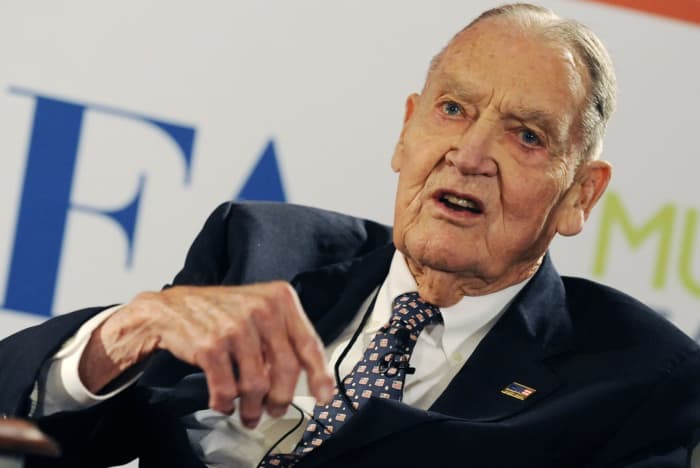
John C. “Jack” Bogle, the late founder of the mutual fund company Vanguard Group.
Bloomberg
Jack Bogle created the first index fund in 1975, introducing an ultra-cheap way of getting broad access to the stock market through the Vanguard Group. The idea was to approximate the performance of the market instead of trying to beat it.
Over the following decades, the idea gradually became more popular with investors, who gave up trying to successfully pick active fund managers. In 2013, the shift toward so-called passive investing started to significantly accelerate, as passive’s share of U.S. fund assets began to increase 2.3 percentage points a year as new money flowed into these strategies and away from active funds.
The rise of passive investing was further accelerated by exchange traded funds, which began at State Street in the early 1990s and got a boost when BlackRock purchased the iShares brand. Similar to mutual funds but traded like stocks, investors could buy passively managed ETFs targeting different stock sizes, sectors, investment styles and geographies, as well as commodities and themes such as crypto, clean energy and innovation. State Street
STT,
BlackRock
BLK,
and Vanguard Group became the industry’s heavy-weights.
As a result, the structure of markets changed dramatically, shifting the way equity markets functioned and altering the fee-driven power structure of Wall Street. Today, passively managed index funds exceed $20 trillion and own more of the U.S. stock market than active funds.
18. Unicorns and the rise of private markets

Getty Images/iStockphoto
In 2013, venture investor Aileen Lee coined the term “unicorn” to describe recently started private technology companies valued at $1 billion or more. Private market investing exploded and hundreds of new companies were able to raise massive funding rounds to finance their growth for years without tapping the public markets. Elon Musk’s SpaceX raised $1.5 billion in May 2022, for example, valuing the company at $125 billion. Payment company Stripe was valued at $95 billion while still a private company.
“I typically hear folks refer to greater than $10 billion unicorns as ‘unicorns,’ ‘decacorns’ or ‘dragons’,” a confused Silicon Valley lawyer told MarketWatch. “I have also heard folks refer to ‘super unicorns’, sometimes greater than $100 billion or sometimes [larger than] some other big threshold.”
With interest rates low, private equity also boomed its way to being a $6 trillion industry and some of the nation’s biggest companies were taken private. The public markets shrunk. “We need to study this public market diminishment thoughtfully and deeply,” Jamie Dimon, chief of JPMorgan Chase & Co.
JPM,
wrote in his 2022 letter to shareholders.
When MarketWatch was founded, there were about 7,000 U.S. public companies, but by 2022 that number had tumbled to 4,800. Meanwhile, the number of U.S. companies backed by private equity firms grew from 1,600 to 10,100. Blackstone
BX,
a private equity firm, became more valuable than Goldman Sachs
GS,
the quintessential Wall Street bank known for selling services and trading around publicly traded companies.
“LBO is the new (and better) IPO,” tweeted private equity billionaire Orlando Bravo, contrasting the leveraged buyouts of his industry with initial public offerings that traditionally list private companies on the stock market.
19. Golden age of activists and the buyback boom
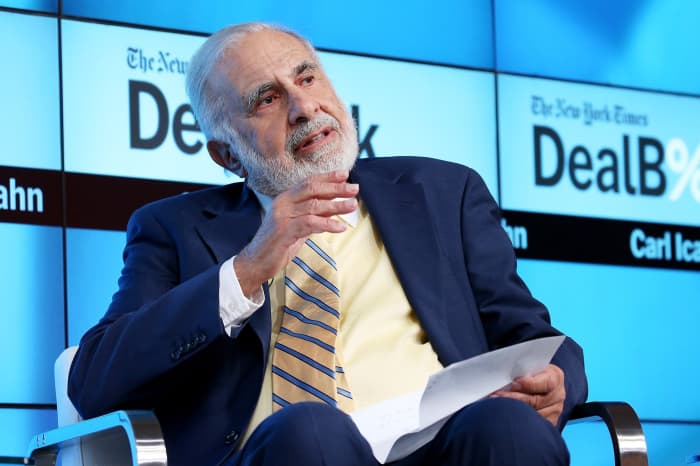
Carl Icahn, chairman of Icahn Enterprises
Neilson Barnard/Getty Images
Hedge funds that purchase minority positions in public companies and demand big strategic changes became a common feature of the markets. Their influence was widely felt. Paul Singer’s Elliott Management grew to be a $50 billion hedge fund and its activist work extended to whole countries, buying the bonds of Argentina and forcing it to make payments on its defaulted debt. Billionaire hedge fund investor Dan Loeb pushed Scott Thompson out of the CEO position at Yahoo and replaced him with Marissa Mayer. Sometimes, the activists made spectacles of themselves, culminating in a live television screaming match between billionaire activist investors Carl Icahn and Bill Ackman.
But more often than not, the activists simply agitated for public companies to return capital to shareholders, often in the form of share repurchases. Corporate America got the message and boards authorized unprecedented levels of stock buybacks, more than $800 billion annually. CEOs got into the habit of buying back boatloads of their stock.
Some politicians, like Massachusetts Senator Elizabeth Warren, decried stock buybacks as “paper manipulation” meant to boost executive pay and called for the money to instead be reinvested in American businesses. But Washington was not able to slow down the corporate stock buyback machine.
20. ESG
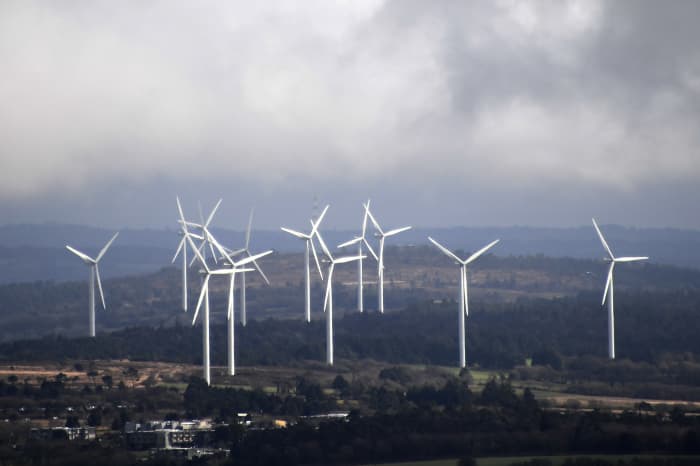
AFP via Getty Images
ESG, or environmental, social and governance, investing was introduced in a market paper called “Who Cares Wins” and aimed to channel investment toward conscientious disruptors or established firms changing the way they do business. The bets included makers of lithium batteries for electric vehicles (the “E”), companies that recruit from HBCUs (the “S”), or those that link CEO compensation more closely to certain metrics, including environmental performance (the “G”).
Starting around 2014, research started to get published supporting the idea that ESG, or sustainable investing as it’s sometimes called, doesn’t have to come at the expense of profit. ESG investors argued they were buying stocks of companies solving problems for the future: preparing natural gas pipelines to pump green hydrogen or bringing younger and more diverse thinking to corporate boards. By one measure, companies within the top 30th percentile on “Culture & Values” in the S&P 500 traded at a premium to companies in the bottom 30th percentile, said the S&P Drucker Institute. Major public pensions in New York and California embraced ESG themes.
Today, ESG investing is estimated at over $20 trillion in assets under management (AUM), or around a quarter of all professionally managed assets globally. That number includes individual stocks, bonds, mutual funds and exchange-traded funds (ETFs). ESG assets are on track to exceed $50 trillion by 2025, representing more than a third of the projected $140.5 trillion in total global assets under management, according to Bloomberg Intelligence.
21. FAANG and the longest bull market in history

MarketWatch photo illustration/iStockphoto
Facebook. Amazon. Apple. Netflix. Google. The longest bull market in history started in 2009 as the financial crisis was raging and ended nearly 11 years later as the pandemic struck. During that time, it often seemed like investors only wanted to buy a few gigantic tech companies. CNBC personality Jim Cramer popularized a term for them: FANG. The acronym later expanded to FAANG.
It wasn’t the first time market behavior could be boiled down to a bumper sticker phrase. In the 1960s, the Nifty Fifty of blue-chip stocks like Dow Chemical and Eastman Kodak ruled the stock market. But in the 2010s, big tech companies captivated investors. In addition to FAANG, high-growth names like Tesla
TSLA,
and Nvidia
NVDA,
dominated market gains.
For much of its run, MarketWatch often noted, the bull market was hated by many market participants. It was partly fueled by monetary stimulus and index funds that didn’t pay fat fees to Wall Street.
Nevertheless, the broad Standard & Poor’s 500 index climbed from 676 in March 2009 to 3,386 in February 2020. It took a pandemic to stop the bull run. As stocks dropped in early March 2020, MarketWatch wondered if the bull market would turn 11 before the developing coronavirus selloff. It did not.
22. Brexit

AFP via Getty Images
The surprise British vote to exit the European Union rocked global financial markets in June 2016 – and was an early indication of new political realities in liberal democracies that were starting to turn their back on globalization. A few months later, American voters would elect Donald Trump to the White House.
Stocks around the world plunged and the British pound dived to a 31-year low against the U.S. dollar after news broke that 51.9% of Britons voted to leave the EU following four decades in the trade bloc. Boris Johnson, now the U.K.’s prime minister, was among the most prominent Brexiteers, likening an exit from the EU to an escape from prison.
MarketWatch reported that appeals to national pride and even nostalgia had roles in “leave” pitches, with English actress and Brexit supporter Liz Hurley saying she yearned for having a “gorgeous navy blue” passport again, rather than one in the EU’s burgundy color. On the other hand, one ordinary Londoner told MarketWatch that she campaigned for the “in” camp partly out of concern that Brexit could unsettle factions in Northern Ireland. That “remainer” made the comments amid a downpour by the Queensway Tube station on the day of the vote. The heavy rains were viewed as helpful for the “leave” side because its voters appeared more determined and likelier to brave bad weather to cast their ballots.
MarketWatch’s coverage featured one staffer in London pulling an all-nighter to cover the market mayhem, as well as Facebook Live broadcasts that broke down what had just happened. We also reported on Brexit’s costly impact on London’s big banks, its fintech scene and the EU millennials working in the U.K., along with how it befuddled bookies and ended up delivering a currency-related boost to the FTSE 100.
23. The COVID crash

People wear surgical masks in San Francisco in 2020 as its mayor declared a local state of emergency.
Getty Images
It was the day the economy stood still — and then started to collapse.
On March 13, 2020, the fast-spreading coronavirus forced then-President Donald Trump to declare a public health emergency. Citizens from many foreign countries were blocked from entering the U.S. and Americans traveling abroad were subject to quarantines.
The Dow Jones Industrial Average sank 19% on the day of the president’s somber announcement, just a month after hitting a record high. It would keep sinking for the next week and, as MarketWatch noted, cap off the worst bear market in more than a decade.
A steadily growing economy was also thrown into abrupt reverse. The U.S. contracted sharply in March and April after state lockdowns and strict limits on public gatherings were put in place. Gross domestic product shrank 5.1% in the first quarter of 2020 and a whopping 31.2% in the second quarter, plunging the U.S. into its first recession in 11 years and one of the deepest in history. Twenty million jobs vanished.
It could have been worse if not for the rapid reaction by the Federal Reserve and Washington. Just days after the president’’s emergency declaration, the central bank cut a key interest rate to zero. It also took other dramatic steps to slash borrowing costs and keep businesses from failing.
Congress and the White House followed up with increased benefits and other stimulus for households and companies to keep the economy afloat.
It worked. The Dow bottomed out at 19,173 in late March, 35% below its mid-February peak. Yet by early April, stocks embarked on what would become a nearly two-year bull market that drove the Dow above 36,000.
Then the economy started growing again.
All the stimulus from Washington, however, would come with a hidden cost. The flood of spending and record low interest rates later contributed to high inflation — the highest in 40 years.
24. Meme stocks and online trading boom redux
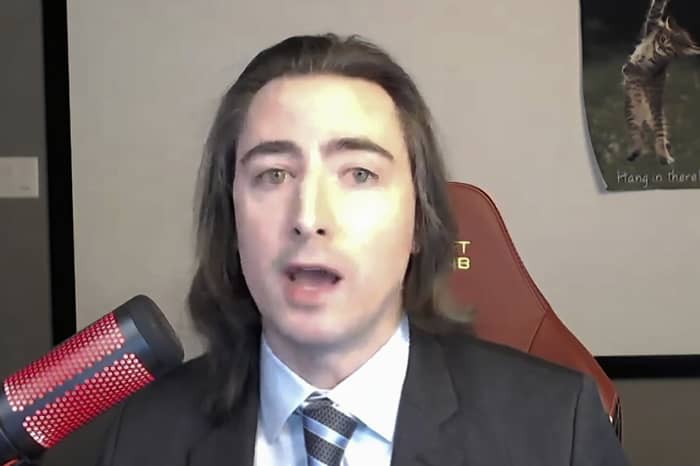
Keith Gill, also known as Roaring Kitty, became the fact of the meme stock frenzy.
AP
Mix together COVID-19 lockdowns, government stimulus checks, a torrent of central-bank liquidity, the advent of zero-commission trading and a new generation of investors versed in online gambling and other Internet pursuits — and you get a new boom in retail investing.
Retail traders accounted for more than 20% of daily stock-market volume at one point in 2021, up from around 10% in 2019, according to market-structure experts. But the frenzy that took hold in early 2021, as investors organized on Reddit and other platforms to take aim at GameStop
GME,
and other heavily shorted “meme stocks,” was far different in flavor from the 1990s dot-com boom. The point for these traders was to punish Wall Street, particularly short sellers, and make money by going long heavily shorted stocks. Options trading also surged, with investors snapping up out-of-the-money calls, adding to the squeeze.
Keith Gill became the face of the revolution. The office worker made tens of millions and created a cult following through his “Roaring Kitty” and “DeepF***ingValue” personas on YouTube and Reddit’s WallStreetBest forum. The Reddit traders used no-cost trading platforms, like Robinhood Markets, and the activity took a toll on some Wall Street heavyweights, with Gabe Plotkin’s Melvin Capital eventually winding down. While meme stock traders didn’t invent the short squeeze, such retail “wolf packs” were a new phenomenon, market veterans observed.
Ultimately, meme stocks crashed back to earth and many new traders were left holding the bag. Meanwhile, some hedge funds minted money trading with and against the meme-stock frenzy, while market makers, like Citadel Securities —another villain to the Reddit crowd—also raked it in.
That said, not all of the surge in retail trading was due to the meme-stock frenzy, with analysts noting that many traders proved nimble in navigating the market’s ups and downs. It would be a mistake, they argued, to assume that the millions of new accounts opened in the midst of the pandemic will simply evaporate.
25. The return of inflation and a bear market

Getty Images
Don’t worry, high inflation is just temporary. That’s what the experts told the public.They were wrong.
The warning signs were there. Former Democratic Treasury Secretary Larry Summers predicted in early 2021 that massive government stimulus would stoke inflation. And a MarketWatch article around the same time suggested inflation was ready to rise.
But no one predicted inflation would surge as much as it did. After falling to zero early in the pandemic, inflation crept higher. Then it hit overdrive. The yearly rate of inflation zoomed from just 1.4% at the start of 2021 to a 40-year peak of 9.1% by June 2022.
Finally recognizing its error, the Federal Reserve stopped calling inflation “transitory.” Then in March it began raising interest rates for the first time since 2018. The Fed had slashed rates during the pandemic to shore up a collapsing economy, but it may have done its job too well. Record-low borrowing costs and trillions of dollars in government stimulus ignited a consumer spending binge.
Businesses were unprepared to keep up. They slashed production early in the pandemic and didn’t expect demand to recover so quickly. Ongoing disruptions in the global trading system added to the misery. Businesses couldn’t get enough supplies and the prices of almost everything rose. With their own costs rising, they started charging customers more. Adding fuel to the fire, the Russian invasion of Ukraine earlier this year drove up oil and grain prices and forestalled a hoped-for decline in inflation.
Now the Fed is trying to undo the damage. The central bank is jacking up rates much faster than it planned. The fear on Wall Street is palpable: A bear market has gripped stocks again. How come? Rising interest rates are expected to slow the economy, dent corporate profits and trigger another recession.
Source: https://www.marketwatch.com/story/the-top-25-market-events-of-the-last-25-years-11665839614?siteid=yhoof2&yptr=yahoo
